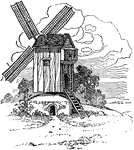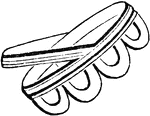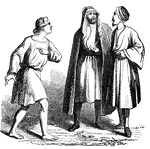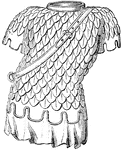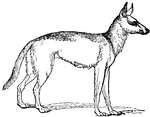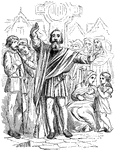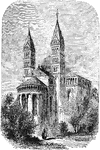
The Cathedral at Spires
The Cathedral of Spires was built between 916 and 1097. It is the largest church in Germany. Designed…
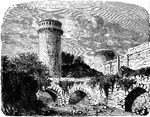
Ruins of Coucy
The ruins of Coucy are what remains of a castle built in about the year 1230 by Enguerrand III, Lord…

Cathedral of Sienna
The Cathedral of Siena is a Roman Catholic Marian church located in Siena, central Italy. A medieval…
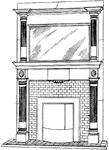
Large Surface Mantel
This mantel piece is also known as a chimney piece which originated in medieval times as a hood that…
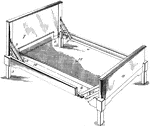
Folding Bed
A folding bed is a piece of furniture used as a place to sleep. Beds usually consists of a mattress…
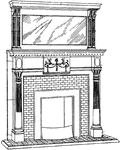
Small Brickwork Mantel
Fireplace mantel or mantelpiece, also known as a chimney piece, originated in medieval times as a hood…

England Fourteenth Century Fashion
An illustration from illumination before 1340 showing period fashion. The coifs worn by the bearded…
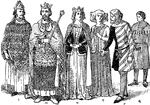
England Nobles Fourteenth Century Fashion
An illumination from the coronation of a king with his nobles and bishop wearing embellished clothing…

England Fourteenth Century Middle Ages Fashion
An illustration of typical English fashion during the fourteenth century. The illustration are, from…
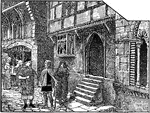
Gothic Street Corner
A reconstructed street corner scene of a house and store during the fourteenth century located in Perigueux…
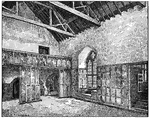
Gothic Architecture Banquet Hall
"The Banqueting Hall at Haddon is a good type of the baronial halls in this century. The minstrels'…

Gothic Architecture City Gate
An illustration of a city gate in York during the fourteenth century illustrating Gothic architecture.…

Gothic Architecture Column
An illustration of Gothic architectural decoration of the column. The column illustrated shows how the…

Gothic Architecture Finial
An architectural decoration of the finial commonly found in Gothic architecture. The finial was used…

Gothic Architecture Alfriston Clergy House
A clergy house in Alfriston, England illustrating typical Gothic architecture during the fourteenth…
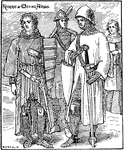
Fourteenth Century Knight and Men at Arms
An illustration of a knight and three men at arms wearing iron armors during the fourteenth century.
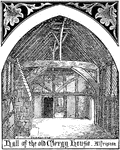
Gothic Architecture Alfriston Clergy House Hall
An illustration of the hall in Alfriston Clergy House. The hall illustrates typical architectural support…
Gothic Architecture Decoration
A Gothic architectural ornamentation commonly found during the fourteenth century. The crocket was a…

Gothic Architecture Parapet Moulding
Illustration of a Gothic parapet moulding used during the fourteenth century. Parapets are exterior…

Gothic Architecture Arch Moulding
A Gothic architecture arch moulding used during the fourteenth century. The mouldings were used to decorate…

Gothic Architecture Arch Moulding Sunk Chamfer
A section of an arch with sunk chamfer commonly found in Gothic architecture during the fourteenth century.…

Gothic Architecture Ornaments Arch Moulding
An example illustration of Gothic architectural ornamentation on arches during fourteenth century.
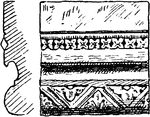
Gothic Architecture Ornaments Wall Moulding
A Gothic architectural ornamentation for wall mouldings. The illustrated moulding is commonly found…

Gothic Architecture Ornaments Column Base
The base of the column illustrating the Gothic ornamentation during the fourteenth century. The bottom…

Fourteenth Century Illumination Ornaments Border
A border ornamentation used in illuminated manuscripts during the fourteenth century.
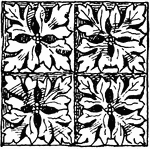
Gothic Architecture Diaper Ornament
A Gothic diaper ornament during the fourteenth century. A diaper ornament is a carved or painted surface…
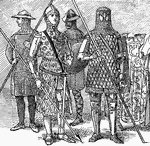
Men at Arms Wearing Armor
An illustration of men at arms wearing iron body armor. The illustration shows armors varied by wealth…
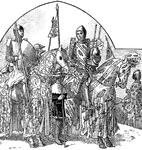
Knights and Noblemen on Horses Wearing Armor
The illustration shows two knights riding on horses. The knights and noblemen wore surcoats to hide…

Sirs John de Creke and John of Eltham Wearing Armor
Sirs John de Creke and John of Eltham wearing armor during the fourteenth century. The illustration…
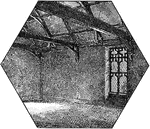
Gothic Rectory in Market Deeping House
The interior view of the rectory in Market Deeping during the fourteenth century. The empty room contains…
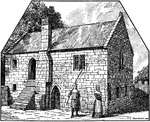
Somersetshire Fisherman's Cottage
An outside view of a fisherman's cottage in Somersetshire illustrating common architectural features…

Northampton St. John's Hospital
The middle window is the tracery found on the St. John's Hospital, Northampton. The two faces on the…
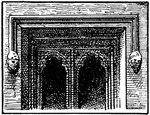
Newarke Gateway Leicester Window
The window from Newarke Gateway at Leicester illustrating typical architectural ornamentation during…

Merchant's Parlour Salisbury House
An interior view of a merchant's parlour in Salisbury during the fourteenth century. The interior have…
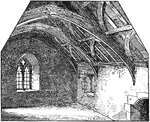
Interior Somersetshire Fisherman's Cottage
The interior view of the Fisherman's Cottage in Somersetshire. The interior of the cottage have a window…

Fourteenth Century War Vessel and Barge
A fourteenth century war vessel with two masts and barge used to transport soldiers. Most fourteenth…
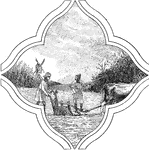
Fourteenth Century Ploughing Field Farming
A fourteenth century illustration of ploughing the field using ox and plough equipment.

Fourteenth Century Harrowing Field Farming
A fourteenth century farmers harrowing the field. Harrowing is a cultivation method to break up clods…

Fire Mantel
This Fire Mantel originated in medieval times as a hood that projected over a grate to catch the smoke.

Hotel de Cluny
An illustration of the Hotel de Cluny in Paris, France. The Hotel de Cluny is a small palace from the…

Ruins of the Church of St. Simeon Stylites
"This church was erected, a few years after Simeon's death, around the pillar (the base of which is…

Carnarvon Castle
"This fortress was founded by Edward I in 1283. It is one of the most impressive of the decayed medieval…

The Antipodes in Derision
"Cosmas lived in the sixth Christian century. In the cut here reproduced from his Topography, he ridicules…

Storming of the Bastille
The storming of a medieval fortress and prison in Paris by revolutionaries, which represented royal…

Gauntlet
The Gauntlet is a piece of protective armor for the hand, dating back to the 12th century. The first…
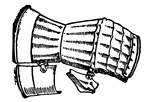
Mitten (Armor)
The 'mitten' superseded the gauntlet of the 14th century. Rather than having separate, unjointed fingers,…
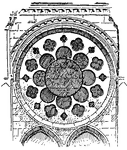
Plate-tracery
In medieval architecture, a form of tracery in which the openings are cut or pierced in slabs of stone,…

King Comforting a Young Man
A king or nobleman sits on a modest throne with a footstool and comforts a weeping young man kneeling…

Chateau of Chambord
The Chateau of Chambord is located in the commune of Chambord in the Loire Valley, France. The castle…

Anglo-Saxon Manor House, Circa 11th Century
Illustration of an Anglo-Saxon manor house or noble's house from 11th century England. There are several…


